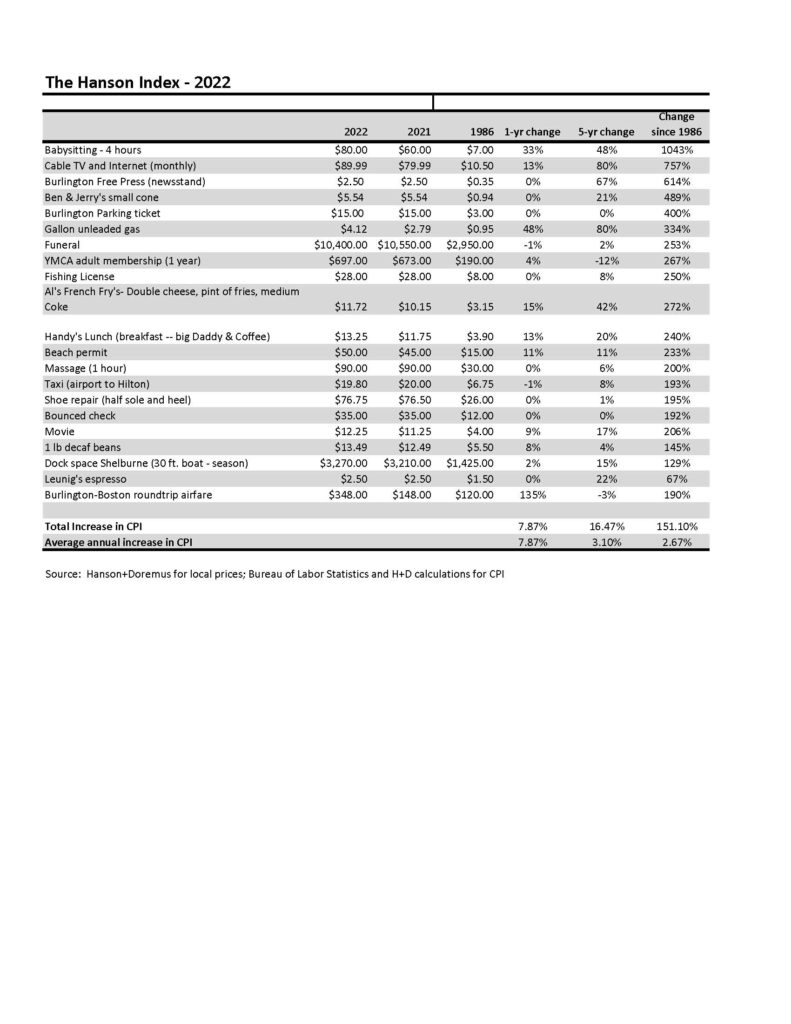It’s our 36th year of tracking the Hanson Index, our yearly lighthearted look at local prices for Vermont essentials like a Ben & Jerry’s ice cream cone or a Burlington beach permit. As you’d expect, prices are mostly up, but luckily, our Hanson Index doesn’t include the worst of the past year’s price hikes like ocean freight rates (+200% to +350%, if you can get a container), nickel (+104%), or used cars and trucks (+37%).
Last April when we published our 2021 Hanson Index, we were in a different world. The economy was steaming ahead, and inflation was rising, but not to worry, said Chairman Powell: Inflation would calm down to 3% or below by the end of the year. Fast forward a year, and that didn’t happen. A war followed a pandemic, and now inflation is clocking in at 8%.
In our humble Hanson Index, the prices of many local items are rising faster than the Consumer Price Index (CPI). The most painful increase is a gallon of gas (+48%). Babysitting costs, according to our very unscientific survey of parents, have gone up by a third – that is, if you can find someone to watch your kids at all. On the other hand, the cost of a Burlington parking ticket has stayed the same since 2014, while Burlington beach permits finally increased for the first time after staying level for a decade.
There always are caveats with our Index. For example, the Burlington-Boston roundtrip flight has changed so much over the years that it’s hard to get a handle on the airfare. The direct flight that existed when the Hanson Index started in 1986 was discontinued in 2001. A new direct route started in 2021 but didn’t make it even to its first anniversary (due officially to “staffing issues”). That means the $348 fare shown here represents the lowest price for connecting flights. But who would fly through Newark to get to Boston in six hours when you can take a bus for $65 one-way and get there in less than four?
The price of a “standard” funeral too has gotten harder to measure as the range of options and extras has widened. And we’ve had to drop two items outright this year — a no-fault divorce and a BMW tune-up — because there is no longer a meaningful “standard” price.
This is the problem with tracking a basket of consumer goods. As the Bureau of Labor Statistics (BLS), the tabulator of the CPI, says, “some items being priced in the sample come and go from the marketplace,” and replacements are hard to find. In addition, while it’s straightforward to measure the prices of rice or cornmeal, the BLS must make “hedonic adjustments” to account for quality improvements — for example, for televisions today being vastly superior to those of even a decade ago.
We are not that scientific — that would just take all the fun out of it. But we will have to make a few changes next year to replace what we dropped. The thing is, replacement isn’t as simple as you might think. It’s easy to come up with typical consumer items we don’t track today — like Netflix or an Amazon Prime account – but the trick is to find things that will last for decades. That’s easier said than done.
